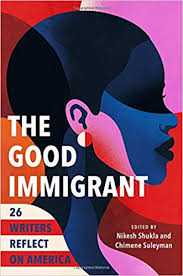In doing so, they engage with the most vital question we now face: What do we want America to be? They cannot speak for all immigrants, but their stories illuminate a whole world of experience that is too often hidden from view. The time has come to reclaim the narrative. — The Good Immigrant , Nikesh Shukla
This book introduced me to some of the most powerful stories about life in America, written by a diverse set of authors willing to delve into their personal upbringings. Although some stories resonated with me more than others, I wanted to highlight every one of these writers to recognize their brilliance. In order of their stories’ appearance in the book, the writers are:
Porochista Khakpour, Nicole Dennis-Benn, Rahawa Haile, Teju Cole, Priya Minhas, Walé Oyéjidé, Fatimah Asghar, Tejal Rao, Maeve Higgins, Krutika Mallikarjuna, Jim St. Germain, Jenny Zhang, Chigozie Obioma, Alexander Chee, Yann Mounir Demange, Jean Hannah Edelstein, Chimene Suleyman, Basim Usmani, Daniel José Older, Adrián and Sebastián Villar Rojas, Dani Fernandez, Fatima Farheen Mirza, Susanne Ramírez de Arellano, Mona Chalabi, and Jade Chang.
Edited together by Nikesh Shukla and Chimene Suleyman, these beautiful stories gave me a sense of wonder into the experiences of people from all over the world, linked together by both the optimism and harshness of immigrant life in America. For the families of these writers, the idea of coming to the United States meant the prospect of a better life for themselves and their children. However, I found many of these writers to instead question the very idea of what it means for a better life.
What these writers make clear to me is the variety of struggles felt by many immigrants in America. Whether that is from growing fear after Trump’s election, constant trouble with airport and border security, or conflicting values between their generation and their parents’ generation. These stories communicate the conflict between better living conditions in the United States against the complex racial structure meant to benefit white people over non-whites.
As a foreigner studying in the United States, I related to many of the points made in this book. In particular, I was in the same boat with many of these writers in their discovery of a racial hierarchy in the United States. Before coming the United States as a fifteen year old, I held basic knowledge of the history of slavery and the prejudice towards African Americans. I had not even touched the tip of the iceberg that is racism.
In the same way, these writers, whether growing up in the United States or moving to America later in their lives, learned about the inherent structure that disadvantaged non-white individuals, with the narrative becoming even more complicated when you consider stories about the ‘whiteness’ of immigrants or the prejudice towards being Muslim as inherently tied to race.
Ultimately, each writer tells the story of their individual experiences, expanding the narrative of immigrant life in America, but not so much as to represent every single immigrant experience. What Nikesh Shukla reminds us in the compilation of these stories is the complexity embedded into the American social structure. When every immigrant holds a unique story to tell, it is important to recognize each one, and to continue to promote the stories of those pushed into the backdrop of American society.
